Part 1 - Part 2

The First Estuary: Mandina And The Gambia River
When we arrived at Banjul airport to our shame we did not realise that English newspapers were so valuable. Several people stopped us and asked us for them and we felt embarrassed that we had just left ours on the plane. There were also people wanting us to change the English money they had received as tips into Gambian Dalasis.
The colourful, dusty hustle was the same as when we had passed through here 16 years ago. But back then the airport was just a landing strip left over from colonial times. Customs was just a row of wooden tables under a corrugated iron roof. Now there is a small, white modern airport with a crescent roof and hoards of Europeans in search of winter sun. We gave our bags to a porter who hustled us through customs very quickly. Well worth the fifty Dalasis. We were led to a mini bus and waited for the rest of the people going to Mandina River Lodge. First up was a young bloke in a baseball cap.
Together we waited and waited. Eventually an elderly couple from Yorkshire (Halifax, the man said emphatically) arrived. They had lost a suitcase so had had to wait till everything was unloaded and collected, then deal with the reps. We discovered later that the young bloke, Nick, was a travel journalist on an assignment. Like us, he was heading on to Senegal.
We eventually set off out through the thinning throng in the car park and hit the road. The villages along the route had everything for sale. There were little stalls selling food and clothes and every kind of service or manufacture you can imagine: welding shops making louvered windows, doors and every kind of metal object. Then there are the wood workers. We passed a cattle market with goats tethered to old lorry tyres.
After about 40 minutes we turned down a dirt road and entered Makasutu, the Holy forest. Its 1,000 acres are home to five different eco systems, a great assortment of wildlife, and - for the next four nights - us.
Sometimes you feel like you are a walking ATM dispensing Dalasis. It was a thought that popped into my head as I sit and contentedly watched the tide change on the creek in the late morning.
This is our last full day at Mandina River Lodge on a tidal creek at the edge of the mangroves in the Makasutu Forest, two to three miles off the Gambia River. We are in the process of 'dashing' - that West African term meaning giving praise and respect with gifts of money. Tipping in other words. The basic wage of the workers is so low that they depend on tips to a very large extent. We did Dominic a barman last night and Lamin our guide and Bara our cleaner this morning. We've still got Ayesha, the girl who serves us at lunch; probably the gardener as well. Though I hope it's not the gardener who left the water on overnight and drained the tanks so there was no water for showers. Good thing we got up late that day - it was fixed by then.
Mandina River Lodge is very relaxing. We are on 'Floating Three'. At Mandina there are four rooms built on pontoons floating in the creek. The big bedrooms with their carved wooden beds and mosquito nets have outdoor sitting areas at the front and side and an open air shower and high tech composting toilet at the back. Large glass doors and windows give you an almost 360 degree view. There is a high thatched roof with a ridge beam shaped like the keel of the local boats - pirogues. There is also one large house on stilts in the river and three jungle lodges. The bar and restaurant have poles supporting thatch made into two soaring chimney roofs.
The creek and its thick entwined mangrove banks have a world of their own. There is the ebb and flow of the three-to-four foot tide and all the passing traffic. Like the four women paddling dug-out canoes - real ones fashioned from a whole tree - who are regular visitors. One time they had a dog who followed them trotting along the bank through the mangroves. The women are oyster fishers. They sit balanced on the rear of their canoes, legs asplay on the gunnels. The water almost comes over the back but obviously it does not cause a problem as all the dug-outs are like that.
These oyster women are pretty tough cookies. They paddle out quite a distance on the ebbing tide to their current gathering area. They harvest and then move on to another place to allow the bivalves to regenerate. They use a large knife, described to us as a cutlass, to prise off the oysters growing on the mangrove roots exposed by the falling tide. It is rough, hard work. When they return on the flowing tide you can see the canoes piled high with these oysters. They boil them in large cauldrons and extract the meat, which is more like a whelk. The best of the oysters get sent to market and the rest are kept for themselves and their families
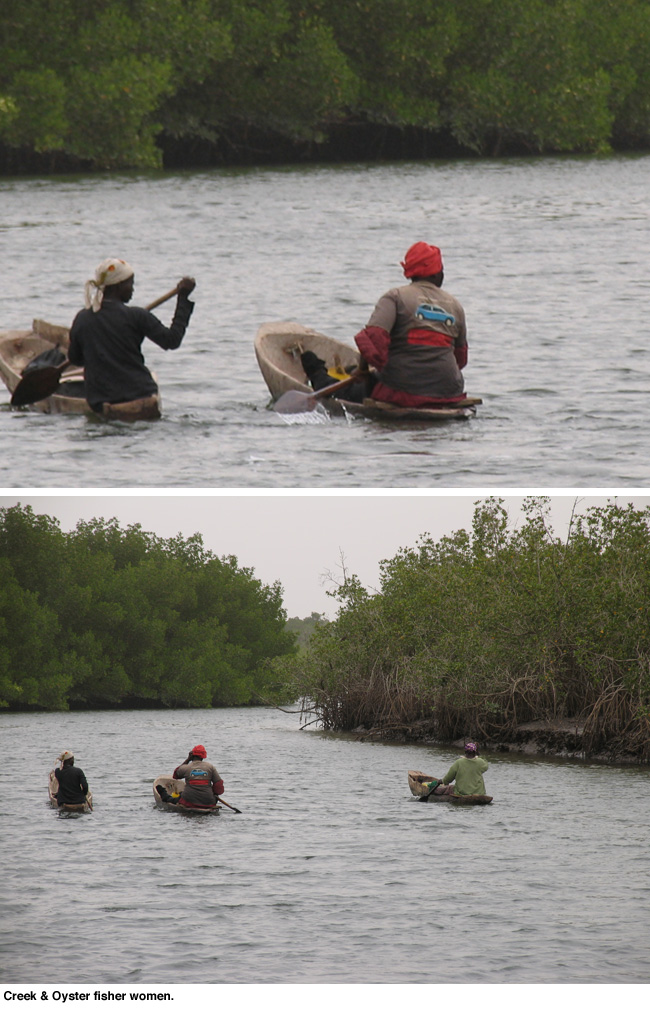
There are a number of semi-domesticated cats around the lodge. The matriarch is a ginger called Jenny who follows you back to the rooms. She liked to spend the day sleeping with the guests. Kim gave her a saucer of the milk that came with our early morning coffee. Jenny repaid the kindness by letting her fleas bite Kim.
As I write this a little motorboat comes into view. But it looks like it is heading up the other creek to the nearest village. We went there yesterday in a boat trip.
When we arrived we noticed that our floating room had its own boat moored outside - well, a large wooden canoe about fifteen feet long. Our guide, Lamin, came to us at about 4 o'clock yesterday and we took this boat and headed out on the ebbing tide. We worked our way up the estuary for about an hour, past endless mangroves, until we reached the village, which by and large operated in the same way it had done for hundreds of years. When we turned round to return the tide was against us and Lamin had to paddle very hard to make progress.
The whole ecology is pretty interesting with lots of birds. I can see why the Gambia is described as a birders' paradise. It is quite spectacular. Evidently Bill Oddie stayed here at Mandina, but I don't hold that against them. My favourite birds I can see from the room are the Blue Cheeked Bee-eaters. They are bright blue and green and their triangular wings and tail looks like a kite when they are flying. They swoop and glide with great fluidity, only deviating when they dart in one direction or other to catch an insect (presumably a bee). They also cheep away to each other when they are flying.
Fish are always active in the creek catching fallen insects. The creek really does have a constantly changing pattern of its own. Even in the time I have been writing this the creek has gone from completely still to quite speedy. Our boat has swung around the other way as the tide goes out and the water is full of all the leaves shed by the trees that day. The water level has dropped about a foot and a half in about an hour and there is a lot of creaking as everything adjusts between us and the floating jetty which connects us with the walkway that snakes from the rooms through the mangroves to the bar and restaurant area.
I look out and see that the fish, which scavenge anything the tide brings, are lined up on one side of the room. A fish just jumped behind me! Often before the change in tide the kingfishers come out and wait for the change to bring in the fish feeding on the tide.
A man in one of the ancient dug-out canoes paddles by. He has a pile of fishing nets in the canoe and is talking on a mobile phone. That’s life today.
This is the first day it has been bangingly hot and sunny. I would describe the weather on our first two days here as being a gradual acclimatisation. First day it was cold, overcast and with strong winds. I wore a jumper all day which I had not expected to do in this 'winter sun haven'. Next morning it started spotting with rain when we went out with Lamin on an early morning bird walk through the Makasutu forest. There were light showers all day until it cleared up in the mid-afternoon, which allowed us to go out on our boat trip.
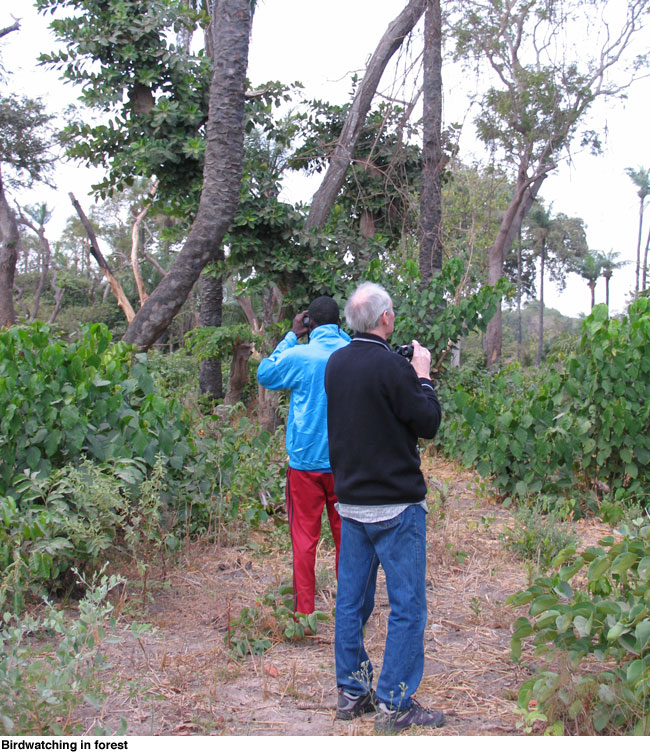

A bonus on the morning bird walk was seeing the agricultural plots the local community uses to grow rice in the wet season and vegetables the rest of the year. There were little fireplaces where the women cooked their food while working and brightly coloured, gardening bowls and plastic buckets hung on the woven palm frond fences.
That night we took a journey up the river to the dancing, a cultural event organised by the Makasutu project in the forest. We made the short journey by boat to the cultural centre after dinner. Tourists from the beach hotels get bussed in for a barbeque and some craft shopping before seeing the local storytelling and dancing featuring the history of the tribal people of The Gambia. The predominant tribe in this area are the Mandinka. They came from Guinea and Mali in the eighth century, deposing the Ghanaian Empire that had ruled before. In my view the performance was a bit hokey and went on for too long and there was little variety in the dancing. The best bit was a straw marabout - the traditional healer - who had a long wooden pole sticking out him, which he pushed to the ground and spun round on it, the straw whirling around like the brushes in a car wash. Very impressive.

And now I'm sitting here watching the fish just in front of me wait for titbits to float down in the water. The little angel fish are eating algae off the bottom of the canoe. A pied kingfisher just flew past skimming the water. At 4 o'clock the cook turns up at the room to ask us what we want to eat that evening.
I went to the lavatory and saw a pygmy kingfisher sitting on a branch in the mangroves. He was a friendly wren-sized fellow in blue. I called Kim over and she watched him for a while. She said a smaller one, probably a youngster, landed and the parent seemed to say 'Where have you been? Come on let's get going' and they flew away. It is 5.30 now and the tide is about to turn again. There is hardly any movement of the leaves and the canoe has not started to swing.
5.45 and the tide has changed. The boat starts to move. A giant kingfisher comes and sits on our roof. The fish are jumping further up the creek. I spot a big shoal of fish coming up the creek. I wonder if Mr Kingfisher will be tempted. No he isn't. Probably has better fish to fry.
Kim starts to do the packing, preferring to do it in daylight. Then she spends a long time working out roughly how much our bill is likely to be and divvying out notes from the brick of Dalasis we
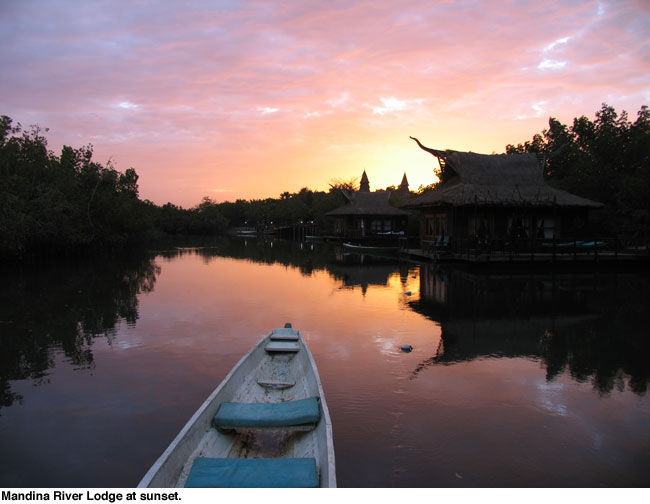
have. Eventually we amble up for our last dinner - barracuda. Very good. Later we go to pay our bill as we leave at 7am in the morning. There is much consternation all round; the 'accountant' is not there - well actually he is the assistant manager. He has gone home. We are reassured we can pay in the morning. Sure enough he is there and he presents us with a bill for 4,600 Dalasis (just over £100). This includes twenty-two 360 ml bottles of Julbrew beer over four days. Outrageous.
We enjoyed Mandina, the setting was fantastic, the floating room a real experience, the staff friendly and helpful. And it was a slightly crazy place, from which the guys who started it with such passion felt strangely absent. It was a great dream that had gone just a bit over the top and did not totally work. It had only been open for six years but you felt it already sinking back into the forest. That was both frustrating and part of its charm.
The Ferry Crossing To Senegal
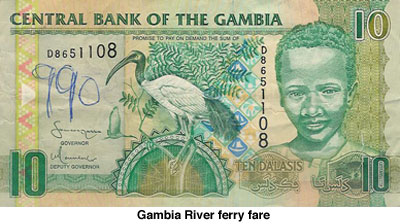
Next morning at 7.30am we are handed over to one Yoro Baa, the owner of the car service taking us to Senegal. Driving a smart new Land Cruiser he is taking us on the first leg of a wonderful journey. He blasts down the rough track from Mandina, bouncing through the ruts. Once we hit the tarmac road he floors it. We do 70 ish through the early morning traffic, lots of overtaking including on blind corners. He says there is a need to 'push on' to get to the ferry.
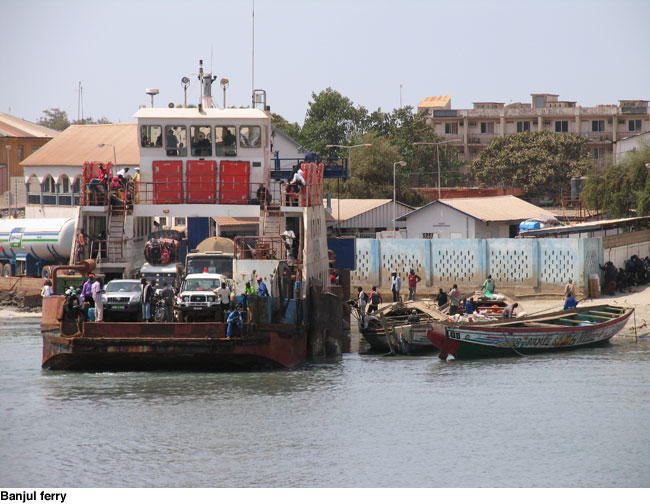
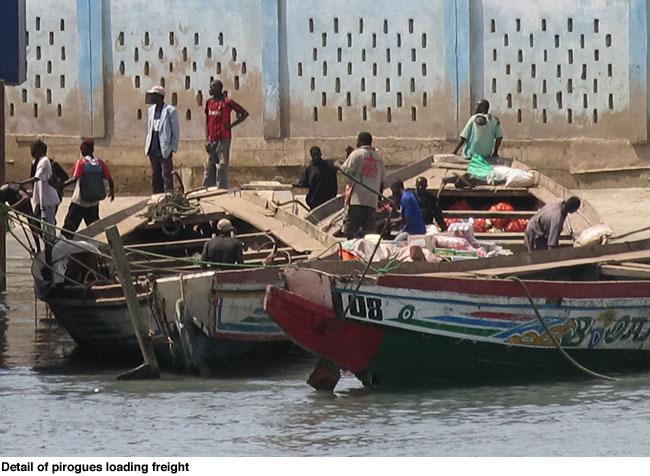
There are three ferries that continuously shuttle back and forth across the Gambia River. We need to catch an early one.
Yoro Baa says he has a way to push to the front of the long queue that always builds up waiting to get on the ferries. And indeed the queue is long and we push right to the front. With a lot of hand signals both friendly and less friendly, alongside liberal use of the horn, we go through some locked gates right to where the ferry docks.
The ferry terminal is a real African hustle and bustle, you might say chaotic. I like ferry rides. All those different elements of humanity squeezed together for the duration of the ride; then fanning out again at the other end in all directions. Because the vehicle queues can be over three hours, our transport guys have a system. They send a car over very early in the morning, at about 6am when the queues are shorter, and it waits for you at Barra on the other side. Boss man Yoro Baa puts you on the ferry at the Banjul side, leaving you in the care of someone he has identified as an appropriate escort. In our case it is a security guard on his way to work on the terminal at other side. We pour onto the ferry with the other foot passengers and grab some seats on the wooden benches on the top, jostling alongside the lorries, motorcycles, handcarts that are being shoe-horned onto the lower deck of the ancient, rusty ferry.
Eventually we chug out of the harbour and pass a large fish market where the fishermen in the colourful wooden boats are still unloading last night's catch. Then we reach the beginning of the beaches where all the hotels are. I spot a high wall with what looked like gun towers at the corners I ask the guard - an interesting bloke - is it a prison or a hotel? He says it is the president's summer home.
The ferry is packed. A woman in traditional dress next to us has two mobile phones in her handbag. I only have one phone and feel for once the more disadvantaged. I mention it to our man. "Oh," he says, "That's normal. For men, you have one for business, one for the family, and one for the girlfriends."
It turns out we are on the slow ferry. It is quite chilly and the crossing takes almost an hour. But it is very entertaining with people coming round selling everything from food to cheap fake watches, and torches with a radio in them! A guy tells me I have dirty shoes but they are good shoes and he can wash them for me. Indeed they are a bit grubby but will get even grubbier by the end of the holiday. When we finally dock at Barra with an almighty clang the chaos starts again as people fight to get on early as we fight to get off! No time for niceties or politeness everyone just pushes through.
As soon as we hit dry land our next driver, Essa, is waiting for us. We thank our escort and are handed over. We soon make our way through the jungle of shops and commercial buildings that form the entrance and exit to the ferry. We take a road under construction, still just gravel, soon hit tarmac and the little villages, huts and farmers die out. It is quite flat and getting more arid. We arrive at a small town called Keran where the main street is being repaired, so are directed round 'the by-pass'. This takes us round the back of the shops past an open air market then back down a narrow lane with shops piled high with sacks of rice and all kind of goods. Dunno which way the lorries overloaded with sacks we saw on the road went.
We come out on a big square which is the border with Senegal. Essa takes our passports to be stamped; we do not even have to get out of the car. The world comes to us though. First I buy a bag of cashew nuts from a young girl. I pay 50 Dalasis - 20 is the regular price - and immediately the car is thronged with people trying to sell us something or beg from us. One little girl wants a gift of pens or lipstick and she won't give up and keeps pulling faces at us. She asks me to take off my sunglasses! An older hustler tries to open the door and I wave a finger at him, pulling the door shut. The kids are professionals who work the border every day. They leave their handprints all over the windows, a graphic reminder to take with us of their scrabble to make a living.
Essa comes back with the passports and we move fifty yards up the road so that he can get the paperwork for his Gambian car stamped. We sit and watch the activity around us. People come and shake hands with the policemen, exchanging folded money. Essa comes back and suggests we change some Dalasis into CFAs (the Senegalese currency). He winds down the window and beckons a man carrying a fistful of money and we do the business. 500 Dalasi buys 5,000 CFA. Everything stamped and in order we head off north into French-speaking Senegal. The outskirts of this border town are pretty funky; as are the small towns and villages we come across on the road.
The lorries belching black smoke all seem to be vastly overloaded. The roads vary in the pothole quota. Some are good, others just appalling. At one point it is quicker to go off piste and bowl down a sandy track parallel to the road at 40 mph rather than pick our way through the craters on the road at 0 mph. We come across all kind of sights and fauna: donkeys lying down in the middle of the road, suicidal goats. We go through lively little villages and minor towns. There are a lot of police roadblocks for a while after the border. They stop you for all sorts of reasons. We are stopped to check if the car has the obligatory fire extinguisher. Given the state of some of the cars on the road a fire extinguisher is the last thing needed. There are also customs checkpoints to stop people bringing back cheaper sacks of rice from the Gambia and not paying Senegalese taxes.
After a few hours, around midday, we cross the Saloum River at a town called Kaolack, a pretty amazing place. Like all great river crossings and crossroad towns it is a hive of activity. First up are the salt factories with their patchwork of square ponds evaporating salt out of the estuary water. Then there is a large automotive repair area - just rows and rows of little shelters where every kind of lorry, bus, taxi or car is repaired. Broken down and cannibalised vehicles are piled up in front of them. There is even a row of panel beaters and bodywork experts, and collections of puncture repair places. It is an apocalyptic, vibrant, confusing mess of everything and looks like something from the Mad Max or Blade Runner films. Next is a market which seems to spill into the road and you have to literally force your way through the people, carts and stalls. We take a left turn and pull up outside a restaurant for a drink and loo break.
As we are drinking our Sprites I see a pickup truck drive by with a PA system on the back and a bloke shouting something over it. I ask if it is an election or an advert. It is an advert for a mobile phone company. You can say what you like about the ubiquity of mobiles but they are one of the few modern inventions that have actually liberated people in Africa. The other object would probably be the car. Five hundred CFAs lighter (85p) for the three Sprites we move on, passing more of the old Peugeot 505 cars that are often used as taxis, and equally often stopped by the roadside with the bonnet up.
Sometimes the cars look really beaten up, the front lights and grill missing, rear lights as well, the boot flapping loose and lots of crumples just painted over. They look like they have been welded together from four different cars and left on a scrapheap for twenty years then had a hard life as a taxi for another ten.
We are about half way on the journey now. Because of the width of the Saloum River you have to go up a long way to find the first crossing point, then turn left and head for the coast, then left again and go south to the village of Palmarin, our final stop. The roads get very bad in places. Evidently the lorry drivers had gone on strike the week before complaining about their bad state. Ironically it is their overloaded trucks that do the most damage to the roads.
The Second Estuary: The Sine-Saloum Delta
About eight hours after we left Mandina River Lodge, we come to a little town called Fatick and head down into what is known as the Sine-Saloum. Here the land changes to huge expanses of salt flats and pans. We join a causeway through their wide flatness. In the wet season it is all flooded but now it is brown sand baked hard by the sun. The surface is compacted and harder than concrete, which allows vehicles to make short cuts across the pans.
Everything has a washed out fawn-ness with varying shades of yellow and brown. We bump up again onto the causeway and eventually see a sign for Lodge des Collines de Niassam. We turn down the road and stop at a green metal hut, which marks the entrance to the nature reserve and our driver is interrogated by a man with a beret and Ray Ban aviator sunglasses. We seem to pass muster and are allowed to proceed. We wind down the road between a jumble of a landscape with large pits evaporating the saltwater and baobab trees coming into sight on the lagoon. The ruts in the track are filled with crushed seashells. We pull into a little turning circle and at last we are at Les Collines.
We go up some steps at the side of a single story wooden building; it is very cool, very minimalist - almost Japanese. Manager Pierre greeted us, tall shaven headed, very French. A dog lies stretched out beside us. It is all very informal, no filling out forms just handshakes all round and the key to Lagoon Four is handed to us. We are then led out past the small swimming pool and bar/dining area. The guy carrying our bag points straight ahead and we can see in front of us about four hundred yards out in the pan is a hillock (the Colline) with three baobab trees growing on it. At the base of the hillock there are two wooden circular thatched huts on stilts at the edge of the lagoon. There is a raised wooden walkway to the hillock from the land for when the pans flood in the rainy season.
We are led to Lagoon Four. It is wonderfully simple and basic, a single room with an ornately carved bed and a wooden shelf. A few pegs on the wall to hang clothes and a freestanding cupboard for the rest. A curtain covers the door into the bathroom area. There is a cold water shower made from a few bits of bent copper pipe with holes drilled in them, operated by a chain and some kind of timer. Along the outer wall is a shelf with a wooden basin with a single tap of bent pipe wrapped with twine. And there's a flush toilet. The floor is loose planking with gaps and we can feel the wind blowing through. We also feel that we will be very happy here.
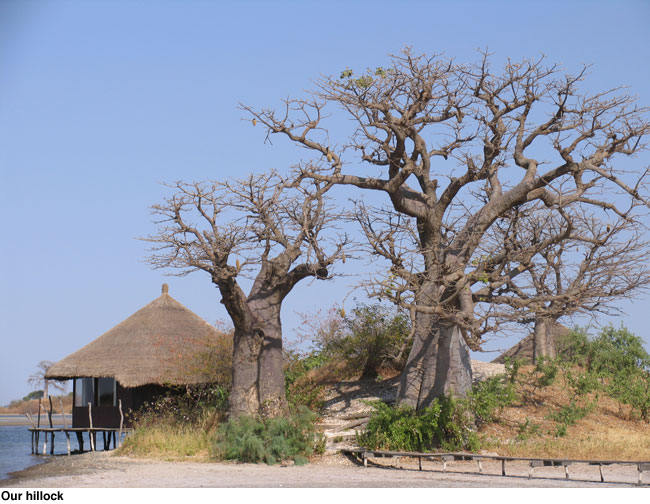
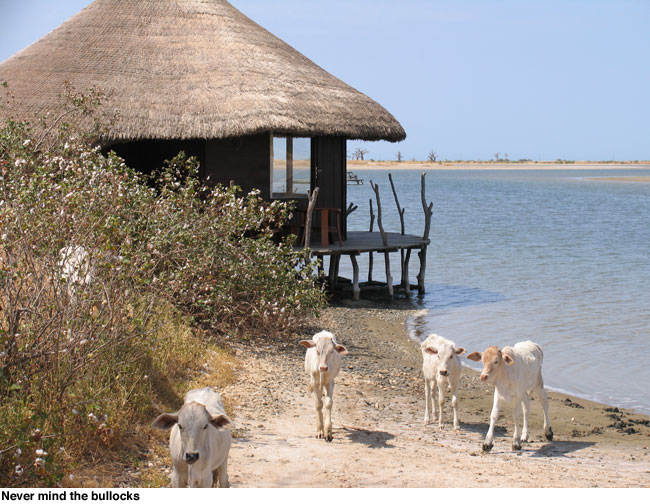
Large windows look out on two sides giving a wide panoramic view of the lagoon and its bird population. You can see about five miles across the pans and a tributary of the Saloum river. You can also see a few other hillocks dotted around as well, covered in vegetation. Similar to the one our hut is on, they are not natural, but man made - huge waste heaps of cockle shells, vast amounts of cockle shells. Ours is about twenty feet high and a hundred yards long. And they have been there a long time. I estimate the baobab trees growing on our hillock to be eight hundred to a thousand years old. We hang out for a while, unpack a bit, luxuriate in the surroundings and get our bearings. I can hear music in the distance but it seems distorted and looped up. I wondered what it was. Next day I work out it was coming from the mosque over the lagoon and river. When the muezzin starts preaching.
Then we go up to the lodge for a beer before dinner. The central bar restaurant area is oblong with a thatched roof held up by large poles and has windows on three sides. A set of tables runs down one side, the bar is a small semicircle in one corner by a door out to the kitchen which is about ten yards away. We go and introduce ourselves to the barman and a couple of French people sitting at the bar. The barman introduces us to a couple of cold Gazelles.
Gazelle is my favourite Senegalese beer. I am happy to make its acquaintance again after a sixteen year absence. The other big Senegalese beer is Flag which, though stronger, does not have the real sharp hoppy bite and full taste that Gazelle does. We wander around the room looking at the large map of the region propped up and the various books about the area. There is a "shop" set out in one corner with locally made objects for sale. We also take stock of the other guests. Apart from the French couple we see at the bar there are four English people, which is not what we had expected. One laughs a lot and is the dominant voice. I call him Mr Voice. There is also a trio of serious looking middle-aged Italian men.
We sit down to dinner outside on the veranda, looking over the pan to our hut, sorry room. The food at Collines is delicious, classic French quality cooking. Tonight it is a chicken leg that the meat just drips off and a real proper jus. Contentedly we wobble off to Lagoon Four. It is windy and a gale blows through the floorboards. We find the big thick padded cover for just such nights to put on the bed. It is very warm and snug and we sleep very well. It has been a long day; a lot has been seen and experienced since we left the last estuary at 7.30 this morning.
I wake at about 5.30 - 6.00am and can see a gentle tinge behind the curtains. I draw the curtain back and there is dawn just coming up. Fantastic peachy colours contrasting against the steely grey of the water. Then a flock of pelicans and cormorants float by, fishing away. It is a real pleasure to watch this. I wake Kim up so she can share it. She is pleased to have been woken up.
At 7.30 the hot water arrives. It had been explained to us that because it is cold at the moment (it is) if we want we can get some hot water in the morning. "Yes please" we said, "One bucket or two?" "Oh two please," we chimed.
We get two plastic buckets which are a quarter full of hot water, with mugs whose handles fit over the edge of the buckets, both in a fetching sort of red and green flecked pattern. You dilute the hot water with cold from the shower and pour it over yourself. It actually works very well. I use the last of the water in the cup for a shave. This washing ritual becomes one of the pleasures of Collines. It is my birthday today so I open all the cards and gifts that have been kindly sent to me in advance. We put them all up on the wooden shelf. Kim has made me a card from things she found locally. She stuck puffs of cotton from the cotton bush next door onto it with her hair gel and added the Happy 2009 sticker from our bottled water and then wrote her message with the coloured pencils we had brought for the local school. I am a happy birthday boy.
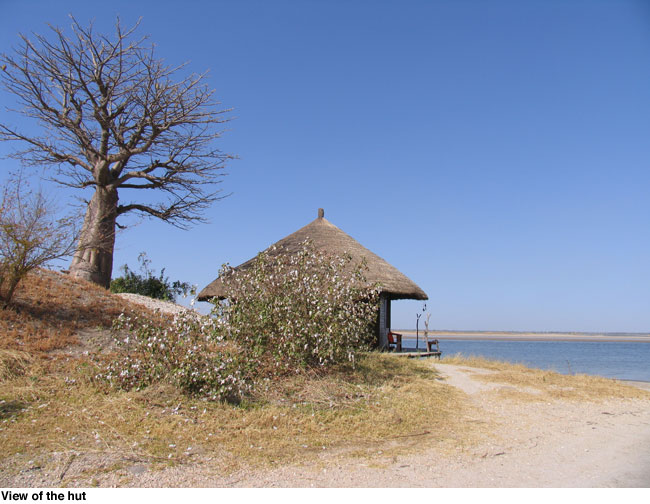
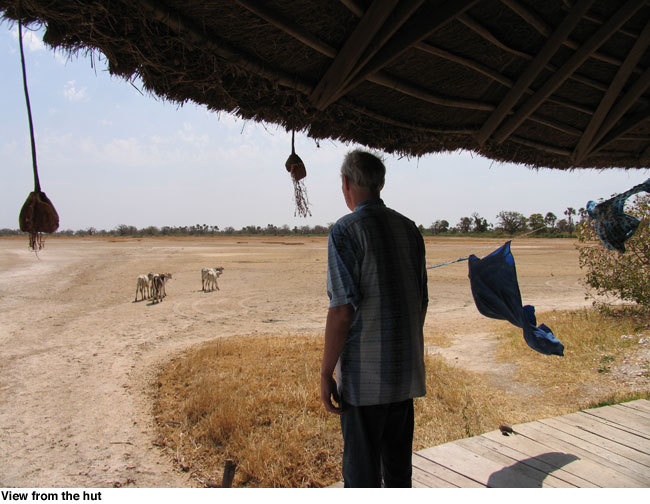
We toddle off to breakfast, real coffee at last! Mandina's had been instant. Lovely fresh-baked, crusty demi-baguettes, jam, and fruit. Then we amble back to Lagoon Four where I set about making my usual nature table type thing from objects I find in the local vicinity. We decide to explore the salt pits just further up the lagoon. It also gives us to chance to get the bigger view of the local area. We set off the along the water's edge and soon the amazing quality and very varied colours of these salt pits display themselves. First up are the pits themselves, dug about 6- 9 feet down and 20 feet (or larger) across. The salt crust on the evaporating water filling the pit is scooped up and piled up in a cone about four feet high, ten feet across. Then the pile is covered with bits of old material, palm leaves, bits of plastic anything in fact that can let the salt dry out more but protect it. We come across one young guy standing with a spade breaking up a big pile of salt and transferring it to his donkey cart. The donkey is chewing on a bag of groundnut plant tops. We speak a bit - to the guy not the donkey - he asks for a cigarette and we have to say sorry.
To his left a couple of women are cutting down some kind of spiky gorse to lay around the perimeter of the mounds to protect and hold them together. They pile up the cut branches in little square piles. It looks like something artist Andy Goldsworthy would do. This weird landscape is an overgrown World War One battlefield, pock-marked with craters, abandoned detritus and these piles of salt looking like emergency shelters thrown together.
We have been accompanied on the walk by three dogs, one of them extremely boisterous. It loves bits of plastic it finds in the pan which it attacks with vigour. It races here, there and absolutely everywhere, causing as much trouble as possible, while the other two are much more relaxed. They follow us back to the hut and find a nice warm position on our deck and go to sleep. Except for boisterous dog, who keeps nudging me. Next thing I know he has his entire jaw around my leg just above the ankle. I said NO firmly, whack him on the head and pull my leg away. We retreat inside the hut but the naughty dog tries to follow, attempting to push his way in. Kim bangs her flip flops together and that dissuades him. Frightens the life out of me as well.
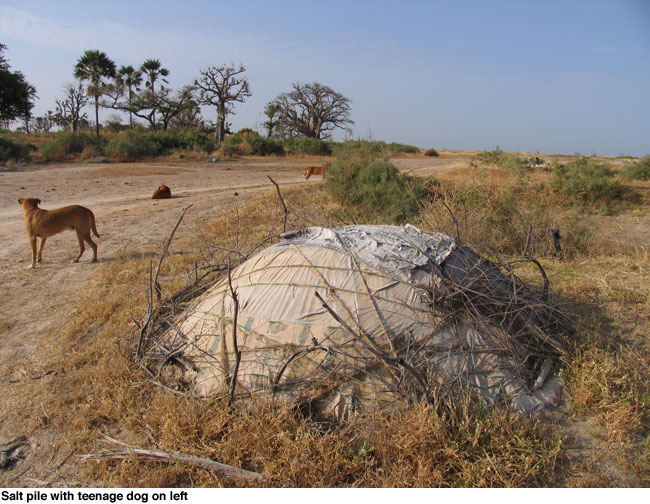
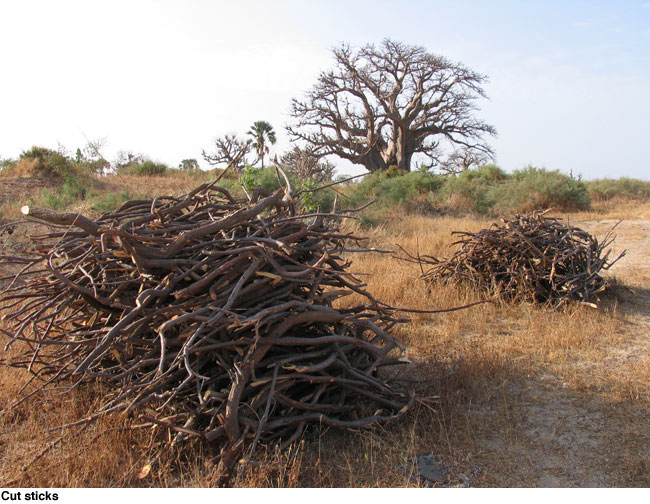
This young dog seems to be overdosing on energy and testosterone so we give him the name Teenage Dog. Teenage Dog then sets about chewing on a vertical branch that marks the edge of the decking. I can see the deep chew marks he has made in the hardened weathered wood. I think about him doing that to my leg bone, but the thought is not even worth thinking about. Then he starts having a go at parts of my nature table assembly. First up is a piece of driftwood I found. I had hung it up on one of the upright branches on our deck. He starts chewing the end first, then gets more interested. He eventually gets it unhooked after a lot of hard work pushing and twisting. Then trots off twenty-five yards into the pan with it, plays with it a bit, loses interest and chews up a pelican feather instead.
We take the opportunity to get ready for dinner by having a wash in our now mildly sun-warmed ambient temperature shower. I must admit it is pretty invigorating once you get in it, quite refreshing. When we emerge ready to go Teenage Dog comes bounding over from where he has been lying on the pan. He immediately attacks another part of my installation - some threads of cotton I have spun by collecting a load of cotton balls from the cotton bushes outside Number Four. Teenage Dog rips them apart. The other two dogs who had been lazing fast asleep on our decking, sense we are making a move so get up and follow us up to the lodge. Teenage Dog follows them. I go and retrieve my branch, now with extra chewing on it
Up at the lodge we ask about the dogs. The nice two, the mother and son, are house dogs but no one knows where Teenage Dog came from and certainly he is not welcome at the lodge. But there is a distinct family resemblance. We shall never know.
That night Teenage Dog gets very bold. First he will not leave us alone, trying to eat our bowl of peanuts and I have to shout at him. He then goes over to the other English people and makes a nuisance of himself and gets shooed away severely. Teenage Dog is soon the subject of a running banter between us and Mr Voice about who had most of Teenage Dog that day.
At dinner that night Gorgui, one of the waiters, asks if we want to go to see go to La Lutte (the wrestling) in the village on Thursday night and also meet his wife, child and family. We say yes please.
The next morning we decide to go for a walk there ourselves. We set off with Mrs Dog escorting us. It takes about twenty minutes to get to the outskirts of Palmarin Ngallou, the largest of the three Palmarins along the coast. We skirt round the edge of the village to where the fishing boats are hauled up on the beach. It is a very busy place. The men are divvying up the catch from a boat while women are drying fish in the sun laid out on a series of tables.
The thing that I find depressing about many of the African villages we have come across is the rubbish. Our throwaway plastic society does not serve them well. Everything is dumped at the edge of the village: bottles, plastic bags, every kind of container and general detritus. Here the beach - though a working beach is always going to be untidy - is a tip.
We go through the village saying "bonjour" to everyone, including many giggling children. Palmarin is a mixed village religiously. There is a Muslim school, mosque and cemetery and also a Catholic church, cemetery and school. We wander through the higgledy piggeldy lanes between the buildings and go into a one-room shop to buy some water. There are a couple of 50 gallon drums of palm oil standing in one corner. A hand-cranked pump sits on top. Sacks of rice are stacked up in another corner. We buy our water and are watched with lazy interest by the four or five other customers.
Having explored a bit more, the sun is well up and we are beginning to bake. We head back to Les Collines, still accompanied by Mrs Dog. On the road we bump into Mr Voice and his wife who have been for a walk the other way up the beach accompanied by Teenage Dog, who now decides to show how good he is at chasing birds.
Part 1 - Part 2